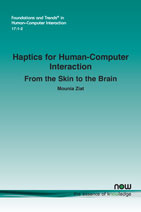Haptics for Human-Computer Interaction: From the Skin to the Brain
By Mounia Ziat, Bentley University, USA, mziat@bentley.edu
Abstract
In recent years haptics has received considerable attention from the field of Human-Computer Interactions (HCI) for its potential to provide more tangible and immersive interfaces. In this work, I present a selected review of research in haptics in an attempt to provide HCI and other fields a framework for understanding haptics that will help those fields design better interfaces and, ultimately, new and better experiences for those who interact with technology every day. This collection of essays exposes the reader to the haptics field, the haptic sense, and some examples of haptic technology. They cover over fifty years of research and terminology thus will be a handy reference for any researcher. In the conclusion, I examine the history in light of my own experiences and provide my take on haptics, HCI and what both communities can do to improve research and design.
Haptics for Human-Computer Interaction: From the Skin to the Brain
In recent years haptics has received considerable attention from the field of Human-Computer Interactions (HCI) for its potential to provide more tangible and immersive interfaces. So much of what we call experience relies on our sense of touch and our sense of where our bodies are in the environment. So much so that we long for a technology that could help us share those feelings. Haptic interfaces are the devices that communicate with our sense of touch and proprioception. From the mild resistance built in to the volume knob on your car stereo that allows you to know how many degrees you are turning it without looking at it, to the full body suit that may soon come to your home gaming system, haptics is a vital and growing part of the world around us and has the potential to augment many aspects of our lives.
In this monograph, the author presents a selected review of research in haptics to provide HCI and other fields a framework for understanding haptics that will help design better interfaces and, ultimately, new and better experiences for those who interact with technology every day. This collection of essays exposes the reader to the haptics field, the haptic sense, and some examples of haptic technology. They cover over 50 years of research and terminology, and thus will be a handy reference for any researcher.
